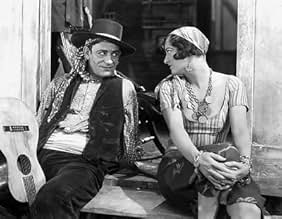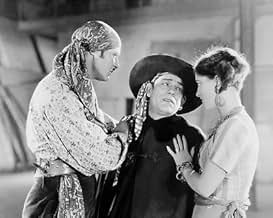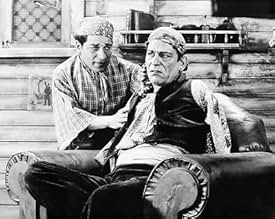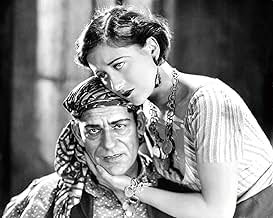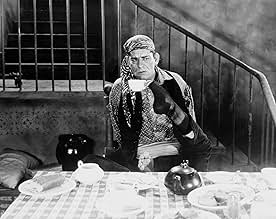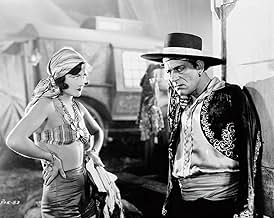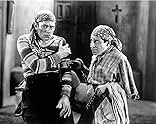NOTE IMDb
7,7/10
9,9 k
MA NOTE
Un criminel en cavale se cache dans un cirque et tente de posséder la fille de Monsieur Loyal quel que soit le prix à payer.Un criminel en cavale se cache dans un cirque et tente de posséder la fille de Monsieur Loyal quel que soit le prix à payer.Un criminel en cavale se cache dans un cirque et tente de posséder la fille de Monsieur Loyal quel que soit le prix à payer.
- Réalisation
- Scénario
- Casting principal
- Récompenses
- 2 victoires et 2 nominations au total
Tom Amandares
- Gypsy running to Zanzis Death Scene
- (non crédité)
Margaret Bert
- Fortune Teller
- (non crédité)
Louise Emmons
- Gypsy Woman
- (non crédité)
Italia Frandi
- Girl in Audience Flirting with Malabar
- (non crédité)
Venezia Frandi
- Woman in Audience
- (non crédité)
Polly Moran
- Landlady
- (non crédité)
- …
Julian Rivero
- Man in Theatre Audience
- (non crédité)
Billy Seay
- The Little Wolf
- (non crédité)
Dorothy Seay
- Spectator
- (non crédité)
John St. Polis
- Surgeon
- (non crédité)
Avis à la une
"The Unknown" has to have one of the strangest plots of any movie I've seen, but I can't describe it without spoiling it. Suffice to say; coming from the mind of Tod Browning who set the story in a traveling carnival, you know it's going to be delving into some heavy weirdness.
"The Unknown" is a silent film starring Lon Chaney, Sr., as carnival star Alonzo the Armless, an expert with gun and knife, who, because of his condition, must use his feet instead of hands. His assistant and unrequited love interest is Nanon, played by a very young and beautiful Joan Crawford. There's a love triangle between these two and the carnival strong man, and oh, what Alonzo won't do to win his ladylove.
My only regret is that I saw the 49-minute version taped off of Turner Classic Movies, and the movie does go by quickly. Short as it is though, it's a weird and entertaining trip.
"The Unknown" is a silent film starring Lon Chaney, Sr., as carnival star Alonzo the Armless, an expert with gun and knife, who, because of his condition, must use his feet instead of hands. His assistant and unrequited love interest is Nanon, played by a very young and beautiful Joan Crawford. There's a love triangle between these two and the carnival strong man, and oh, what Alonzo won't do to win his ladylove.
My only regret is that I saw the 49-minute version taped off of Turner Classic Movies, and the movie does go by quickly. Short as it is though, it's a weird and entertaining trip.
The Unknown is one of the more interesting Lon Chaney collaborations with director/writer Tod Browning, as Chaney's typically physically malleable performance is often executed here in conjunction with "stunt double" Peter Dismuki. It also features a great, early appearance by Joan Crawford, a complex, gripping, allegorically deep but economically told story by Browning, and it is an excellent instantiation of themes found throughout Chaney and Browning's other work. It even strongly presages Browning's 1932 film, Freaks.
Chaney is Alonzo the Armless, a performer in Antonio Zanzi's circus. Alonzo is in love with Nanon (Crawford), Antonio's daughter and Alonzo's assistant in his act, which consists of him using his feet to shoot guns and throw knives around Nanon with precision aim. In a typical Chaney film complicated love triangle, Nanon and Zanzi Circus strongman Malabar are also attracted to each other, but Nanon has an aversion to being touched and keeps distancing Malabar and any other man who wants to be intimate.
Alonzo is the perfect complement for Nanon then, since he cannot manhandle her. She feels safe with him. But Antonio objects to Alonzo's approaches towards Nanon. Complex confrontations and a number of fabulous twists ensue, and Chaney fans will likely expect the resultant profound tragedy with the reciprocally bittersweet "happy ending" consequences.
I probably made that synopsis sound more soap-operatic than it should, since it doesn't very well convey the overall twisted, creepy atmosphere that Browning achieves in The Unknown. Like Freaks, this isn't exactly a horror film, but it has all the unsettling, macabre attitude of one. Alonzo is one of Chaney's more demented, sinister characters, as almost every move he makes has a nefarious, ulterior motive. This even includes the reason that he joined the Zanzi Circus in the first place. It becomes quickly clear that Alonzo will stop at nothing to have Nanon all to himself. But because the character has no arms, he can't very well resort to physical bullying. Instead, Chaney paints a subversive and deviously manipulative character. Even the character's love for Nanon feels wicked--it's more of an unhealthy obsession than love.
Browning makes good use of his largely pared down sets and cast. Except for the opening circus scene, most of the film takes place among only four characters, in only a handful of circus wagon (used later for both Freaks and Chaney's 1928 film Laugh, Clown, Laugh) and apartment locations, with the ending, set in a theater, symmetrically reflecting the opening of the film. A single scene in a formal courtyard provides a nice, symbolic contrast, as does the use of the "extended technique" of a thin piece of gauze placed over the camera lens for some of Nanon's scenes.
Equally economical is Browning's complex story, which tells as much--with the aid of the performances--through implication of various backstories as it does through direct action. The (heavily allegorical) subtexts are fascinating. Nanon is frigid, so her most intimate relationship is with a man who has been effectively castrated. He is so obsessed with her that he'll physically sacrifice himself to enable a relationship. She secretly desires a normal love, but can't have one until she falls into it, or is tricked into it in a way. No one is quite honest with anyone else except for a man who is a relative simpleton, there to be manipulated. But he's the one who ends up coming out ahead, even though he never quite knows what is going on.
Browning had to construct a number of elaborate set-ups to produce the illusion that Chaney had been using his feet to do everyday activities for a long time. We often see Chaney's body but Peter Dismuki's feet, such as when Alonzo is playing guitar, smoking, drinking, and so on. Occasionally, Dismuki just stood in for Chaney, usually when Alonzo has his back to the camera, but at least in one wider shot, we can see Dismuki's face.
The 1997 score on the Turner Classic Movies version of the film by the Alloy Orchestra is occasionally excellent--especially during the climax of the film, and occasionally a bit pedestrian. When it's only pedestrian it's at least unobtrusive. The score has a modern, occasionally "rocky" feel that meshes surprisingly well.
There are a few scenes missing from the print transferred to the TCM DVD, but for many years, The Unknown was thought to have been lost, similar to Browning and Chaney's 1927 film London After Midnight. A print was found at the Cinémathèque Française, mixed in with a lot of other films marked "unknown" because the contents were (at least temporally) unidentifiable. The missing scenes do not hurt the coherency of the film, which is a must-see at least for any Chaney or Browning fans.
Chaney is Alonzo the Armless, a performer in Antonio Zanzi's circus. Alonzo is in love with Nanon (Crawford), Antonio's daughter and Alonzo's assistant in his act, which consists of him using his feet to shoot guns and throw knives around Nanon with precision aim. In a typical Chaney film complicated love triangle, Nanon and Zanzi Circus strongman Malabar are also attracted to each other, but Nanon has an aversion to being touched and keeps distancing Malabar and any other man who wants to be intimate.
Alonzo is the perfect complement for Nanon then, since he cannot manhandle her. She feels safe with him. But Antonio objects to Alonzo's approaches towards Nanon. Complex confrontations and a number of fabulous twists ensue, and Chaney fans will likely expect the resultant profound tragedy with the reciprocally bittersweet "happy ending" consequences.
I probably made that synopsis sound more soap-operatic than it should, since it doesn't very well convey the overall twisted, creepy atmosphere that Browning achieves in The Unknown. Like Freaks, this isn't exactly a horror film, but it has all the unsettling, macabre attitude of one. Alonzo is one of Chaney's more demented, sinister characters, as almost every move he makes has a nefarious, ulterior motive. This even includes the reason that he joined the Zanzi Circus in the first place. It becomes quickly clear that Alonzo will stop at nothing to have Nanon all to himself. But because the character has no arms, he can't very well resort to physical bullying. Instead, Chaney paints a subversive and deviously manipulative character. Even the character's love for Nanon feels wicked--it's more of an unhealthy obsession than love.
Browning makes good use of his largely pared down sets and cast. Except for the opening circus scene, most of the film takes place among only four characters, in only a handful of circus wagon (used later for both Freaks and Chaney's 1928 film Laugh, Clown, Laugh) and apartment locations, with the ending, set in a theater, symmetrically reflecting the opening of the film. A single scene in a formal courtyard provides a nice, symbolic contrast, as does the use of the "extended technique" of a thin piece of gauze placed over the camera lens for some of Nanon's scenes.
Equally economical is Browning's complex story, which tells as much--with the aid of the performances--through implication of various backstories as it does through direct action. The (heavily allegorical) subtexts are fascinating. Nanon is frigid, so her most intimate relationship is with a man who has been effectively castrated. He is so obsessed with her that he'll physically sacrifice himself to enable a relationship. She secretly desires a normal love, but can't have one until she falls into it, or is tricked into it in a way. No one is quite honest with anyone else except for a man who is a relative simpleton, there to be manipulated. But he's the one who ends up coming out ahead, even though he never quite knows what is going on.
Browning had to construct a number of elaborate set-ups to produce the illusion that Chaney had been using his feet to do everyday activities for a long time. We often see Chaney's body but Peter Dismuki's feet, such as when Alonzo is playing guitar, smoking, drinking, and so on. Occasionally, Dismuki just stood in for Chaney, usually when Alonzo has his back to the camera, but at least in one wider shot, we can see Dismuki's face.
The 1997 score on the Turner Classic Movies version of the film by the Alloy Orchestra is occasionally excellent--especially during the climax of the film, and occasionally a bit pedestrian. When it's only pedestrian it's at least unobtrusive. The score has a modern, occasionally "rocky" feel that meshes surprisingly well.
There are a few scenes missing from the print transferred to the TCM DVD, but for many years, The Unknown was thought to have been lost, similar to Browning and Chaney's 1927 film London After Midnight. A print was found at the Cinémathèque Française, mixed in with a lot of other films marked "unknown" because the contents were (at least temporally) unidentifiable. The missing scenes do not hurt the coherency of the film, which is a must-see at least for any Chaney or Browning fans.
The Unknown (1927)
We can see The Unknown today and say, wow, look at the young Joan Crawford. And she does help make this movie come alive, more than even Lon Chaney, who was the big draw for audiences in 1927. Crawford's spark (inspired by Chaney, by her own account), and her character's phobia of men's hands (which she explains quite reasonably, having been groped too many times against her will) make her curious and very sympathetic. She's terrific to watch, and the metaphor of abuse against women is not lost on anyone paying attention.
But Crawford was essentially unknown back then, and the movie depended on the name, and the high dramatics, of Chaney and the other lead male, the charming, somewhat overly chipper strong man in this huge sideshow of a movie. Both are good enough in their roles, Chaney pulling out all the stops in a performance that might be bravura or might just be virtuosic indulgence, probably a bit of both.
And the movie depends on the story itself, the plot, the strange and gruesome series of events, which are gripping at times even if you know what's coming all too well. For viewers then as much as now, there is also the whole milieu, director Tod Browning's leaning to the macabre and the small time circus. This will see a more amazing fruition five years alter in Freaks, shortly after his very successful Dracula (with its self-sustaining sideshow of bizarre, legendary types). But here we have Browning at the end of the silent era, pushing gestures and expressions outward in the place of sound. It's a bit strained, and with the sensational plot, the whole movie lacks subtlety and depth.
What it doesn't lack is high drama, though, and a few surprises. At times touching, at times simply shocking (in its own way), it's enjoyable, and never really flags, which some "better" silent films like Broken Blossoms can't claim. So forget beauty, or elegance or emotional insight and you might really like this.
Oh, and Chaney? He is a marvel of his time, and this film shows him in one of his best roles as an actor, one of many. The armless man is yet another echo of the horrors of mutilated soldiers coming home from World War I and their inability to really assimilate and be accepted. The fact that his character is obsessed with Crawford's we might understand, but it's a love that we don't sympathize with after awhile.
We can see The Unknown today and say, wow, look at the young Joan Crawford. And she does help make this movie come alive, more than even Lon Chaney, who was the big draw for audiences in 1927. Crawford's spark (inspired by Chaney, by her own account), and her character's phobia of men's hands (which she explains quite reasonably, having been groped too many times against her will) make her curious and very sympathetic. She's terrific to watch, and the metaphor of abuse against women is not lost on anyone paying attention.
But Crawford was essentially unknown back then, and the movie depended on the name, and the high dramatics, of Chaney and the other lead male, the charming, somewhat overly chipper strong man in this huge sideshow of a movie. Both are good enough in their roles, Chaney pulling out all the stops in a performance that might be bravura or might just be virtuosic indulgence, probably a bit of both.
And the movie depends on the story itself, the plot, the strange and gruesome series of events, which are gripping at times even if you know what's coming all too well. For viewers then as much as now, there is also the whole milieu, director Tod Browning's leaning to the macabre and the small time circus. This will see a more amazing fruition five years alter in Freaks, shortly after his very successful Dracula (with its self-sustaining sideshow of bizarre, legendary types). But here we have Browning at the end of the silent era, pushing gestures and expressions outward in the place of sound. It's a bit strained, and with the sensational plot, the whole movie lacks subtlety and depth.
What it doesn't lack is high drama, though, and a few surprises. At times touching, at times simply shocking (in its own way), it's enjoyable, and never really flags, which some "better" silent films like Broken Blossoms can't claim. So forget beauty, or elegance or emotional insight and you might really like this.
Oh, and Chaney? He is a marvel of his time, and this film shows him in one of his best roles as an actor, one of many. The armless man is yet another echo of the horrors of mutilated soldiers coming home from World War I and their inability to really assimilate and be accepted. The fact that his character is obsessed with Crawford's we might understand, but it's a love that we don't sympathize with after awhile.
One of the strong points of silent movies is that they are naive in the positive meaning of the word: they are creative.
If anyone does a story like that today, one has to choose to do a drama, a thriller or a black comedy. Browning did not have to choose... he just made a very strange film.
Another plus is the use of running time. No fillers. Just 60 minutes of strange ideas. The film is not perfect; and not anyone will enjoy it. But it features a great performance by Lon Chaney and nice photography (incl. creative use of backprojection). And if you like FREAKS, you have to see this one... the background of Browning as a circus assistant really shows up (though I hope, it wasn't that bad).
Sorry, no story details. I don't want to ruin your fun.
If anyone does a story like that today, one has to choose to do a drama, a thriller or a black comedy. Browning did not have to choose... he just made a very strange film.
Another plus is the use of running time. No fillers. Just 60 minutes of strange ideas. The film is not perfect; and not anyone will enjoy it. But it features a great performance by Lon Chaney and nice photography (incl. creative use of backprojection). And if you like FREAKS, you have to see this one... the background of Browning as a circus assistant really shows up (though I hope, it wasn't that bad).
Sorry, no story details. I don't want to ruin your fun.
I've heard so much about this movie, and it was not a disappointment. The surviving print seems to be missing some scenes, which accounts for its short length, but I doubt it takes away much from this twisted, sadistic "Gift of the Magi" gone bad. Chaney's performance is remarkable and, at times, genuinely alarming, and the very young Joan Crawford is a typical, but nevertheless appealing silent film heroine. Parts of this film really had me squirming, particularly towards the end. Browning's visual sense is the most beautiful I've seen in any of his films other than Dracula, with a full range of greys, whites and blacks and painterly compositions. It's available on TCM's excellent Lon Chaney Collection DVD.
Le saviez-vous
- AnecdotesJoan Crawford always considered "L'inconnu (1927)" a big turning point for her. She said it wasn't until working with Lon Chaney in this film that she learned the difference between standing in front of a camera and acting in front of a camera. She said that was all due to Chaney and his intense concentration, and after that experience she said she worked much harder to become a better actress.
Chaney's performance certainly inspired co-star Crawford who wrote "Lon Chaney was my introduction to acting. The concentration, the complete absorption he gave to his characterization filled me with such awe I could scarcely speak to him...watching him have me the desire to be a real actress."
- GaffesMalabar pushes himself up off the bureau multiple times when talking to Nanon about flowers.
- Citations
Malabar the Mighty, Circus Strongman: There is a time for fear, Nanon... and a time for hate... and a time for love.
- Versions alternativesThe Turner library print has a commissioned score by the Alloy Orchestra and runs 49 minutes.
- ConnexionsFeatured in Universal Horror (1998)
Meilleurs choix
Connectez-vous pour évaluer et suivre la liste de favoris afin de recevoir des recommandations personnalisées
- How long is The Unknown?Alimenté par Alexa
Détails
Box-office
- Budget
- 217 000 $US (estimé)
- Montant brut mondial
- 4 841 $US
- Durée
- 1h 8min(68 min)
- Couleur
- Mixage
- Rapport de forme
- 1.33 : 1
Contribuer à cette page
Suggérer une modification ou ajouter du contenu manquant

